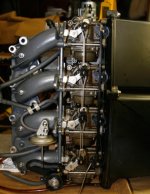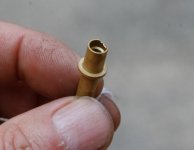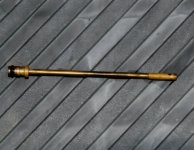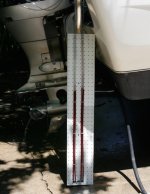RichardW
New member
- Joined
- Oct 13, 2005
- Messages
- 110
- Reaction score
- 0
- C Dory Year
- 2000
- C Dory Model
- 22 Cruiser
- Vessel Name
- C Eagle
About 6 weeks ago, we went out for a cruise on the Tennessee. As usual, he engine started and ran perfectly all day and we clocked about 40 miles before overnighting. The next morning, we headed out into the channel and opened the throttle but the Honda would not get above 3500 RPM and had a vague miss that felt somewhat like ignition and somewhat like fuel delivery. This is the first problem with the engine in 3 years. We spent 7 days cruising in Apalachicola running in degraded mode but at least we were out on the water. Apalachicola is a FANTASTIC town and cruise area. Superb oysters, bay scallops and shrimp available at several eateries. We will be returning soon.
What could have happened over night? The bulb was firm so I switched tanks with no change. I also connected a separate fresh tank with no change. My strategy was to eliminate everything before taking the carbs down.
I tested the secondary ignition, inspected the plugs (and changed them eventhough they were OK. Checked the valve timing, throttle linkage to ensure throttles were opening; they were good. I checked the almost new internal fuel filter and the water separator filter. The separator did have some new rust particles but the internal filter was clean;but I changed them anyway. If the engine has an overtemp or oil pressure condition, the ECU will cut the RPM; but I eliminated this as the cause.
After much flailing to get all of the correct carb parts I removed the Intake / Carb / Silencer assembly and carefully took them apart. I found two anomalies; a chipped main discharge nozzle and two cracked emulsifier tubes (slow jets) but do not think that these caused the problem. I replaced them anyway. These carbs run very lean and have tiny passages and jets so they must be thoroughly cleaned with professional carb cleaner and compressed air. My conclusion is that the passages and jets were clogged in the medium speed and /or high speed circuit of one or more carbs. This is confounding for a well maintained, frequently used engine with new filters.
For the mechanically inclined, here are some photos showing primary components of the Intake Assembly:
Manifold / Carb / Silencer Assy:

Damaged Discharge Nozzle:

Emulsifier Tube:Hairline cracks cannot be seen in this photo

Carb Jets Accessed from Float Bowl:

Carb Jets Accessed from Float Bowl: You may bugger (scientific term) the tips of these caps and jets without proper screwdrivers. My gunsmith screwdrivers worked well. The previous rebuilder did hose up one of the caps.
DIY Manometer:

I designed this homemade Manometer to Sync the Carbs:This measures the differential intake vacuum between cylinders to allow the throttle screw on each carb to be set precisely. The space between each hole in the peg board is only 1/16th In. Hg. The manometer is constructed with 3/16 clear tubing using 2 cycle oil as the liquid. Water could be used but motor oil provides much better damping. Vacuum restrictors are insterted in each of the 4 lines near the intake manifold vacuum port. This setup allows vacuum to be balanced to within a couple of sixteens In. Hg; I believe Honda specs .5 in. Hg balance. This photo was taken after the throttles and mixture screws were adjusted; the levels in each tube were way off at the start of the setup and the engine hacked like a sick cat at first.
The carbs must be synced VERY carefully or it will run like DoDo. I can provide details for anyone interested OR you can just take it to your Honda Marine dealer; this is my recommendation but I do not have one nearby.
Yippee: WE ARE BACK IN FULL CRUISE MODE ; after gagging along like a 1.25 HP Waterwitch, she now purrs like a kitten and screams like a banshee.
I have a little more info in the C Eagle album but I suspect that this is already way too much info; hope I did not make your hair hurt but I wanted to share the pain.
What could have happened over night? The bulb was firm so I switched tanks with no change. I also connected a separate fresh tank with no change. My strategy was to eliminate everything before taking the carbs down.
I tested the secondary ignition, inspected the plugs (and changed them eventhough they were OK. Checked the valve timing, throttle linkage to ensure throttles were opening; they were good. I checked the almost new internal fuel filter and the water separator filter. The separator did have some new rust particles but the internal filter was clean;but I changed them anyway. If the engine has an overtemp or oil pressure condition, the ECU will cut the RPM; but I eliminated this as the cause.
After much flailing to get all of the correct carb parts I removed the Intake / Carb / Silencer assembly and carefully took them apart. I found two anomalies; a chipped main discharge nozzle and two cracked emulsifier tubes (slow jets) but do not think that these caused the problem. I replaced them anyway. These carbs run very lean and have tiny passages and jets so they must be thoroughly cleaned with professional carb cleaner and compressed air. My conclusion is that the passages and jets were clogged in the medium speed and /or high speed circuit of one or more carbs. This is confounding for a well maintained, frequently used engine with new filters.
For the mechanically inclined, here are some photos showing primary components of the Intake Assembly:
Manifold / Carb / Silencer Assy:

Damaged Discharge Nozzle:

Emulsifier Tube:Hairline cracks cannot be seen in this photo

Carb Jets Accessed from Float Bowl:

Carb Jets Accessed from Float Bowl: You may bugger (scientific term) the tips of these caps and jets without proper screwdrivers. My gunsmith screwdrivers worked well. The previous rebuilder did hose up one of the caps.
DIY Manometer:

I designed this homemade Manometer to Sync the Carbs:This measures the differential intake vacuum between cylinders to allow the throttle screw on each carb to be set precisely. The space between each hole in the peg board is only 1/16th In. Hg. The manometer is constructed with 3/16 clear tubing using 2 cycle oil as the liquid. Water could be used but motor oil provides much better damping. Vacuum restrictors are insterted in each of the 4 lines near the intake manifold vacuum port. This setup allows vacuum to be balanced to within a couple of sixteens In. Hg; I believe Honda specs .5 in. Hg balance. This photo was taken after the throttles and mixture screws were adjusted; the levels in each tube were way off at the start of the setup and the engine hacked like a sick cat at first.
The carbs must be synced VERY carefully or it will run like DoDo. I can provide details for anyone interested OR you can just take it to your Honda Marine dealer; this is my recommendation but I do not have one nearby.
Yippee: WE ARE BACK IN FULL CRUISE MODE ; after gagging along like a 1.25 HP Waterwitch, she now purrs like a kitten and screams like a banshee.
I have a little more info in the C Eagle album but I suspect that this is already way too much info; hope I did not make your hair hurt but I wanted to share the pain.
